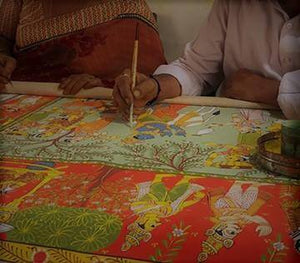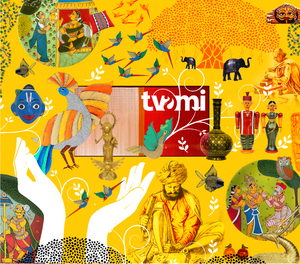
Kavad : Watch kahaanis come to life with this ancient Rajasthani craft
Stories play so many roles - they form bridges to our past, create paths to different worlds, help us understand different people and cultures. They educate, entertain, and most importantly inspire us. Right from the beginning time, humans have always found ways to communicate these stories through ancient cave paintings, sculptures, or scrolls. This desire to share stories comes from a need to be remembered.
Kavad is one such format of oral story-telling that was born in Rajasthan centuries ago. The concept began as a portable shrine, taking little wooden temples to people who could not travel. Decorated wooden panels unraveled fascinating tales from mythology and folklore.

Then the stories expanded from religious epics to moral stories to educate villagers on various moral values like harmony or educating the girl child. Some wealthy families even used kavads to document their family history to be passed down through generations.
Origin
Kavad is a nearly 500-year-old traditional craft from Rajasthan. Kavad means half a door or panel of a door. Each piece requires three people to make it come together; the carpenter or ‘Suthar’, ‘chitrakar’ or artist, and the narrator called the ‘bhat’.
The kavad is hand crafted by the carpenter and artist, while bhats do the narration of the story hidden in every piece of the art. Today, it is mostly sold as a decorative, heritage piece to patrons. The craft is still alive in the village Bassi, in Chittorgarh District of Rajasthan where a few bhats practice it in its traditional form.
What makes it special?
The storyteller travels with the story box. They begin by opening the small outer doors to reveal the story painted on the kavad. Every painted panel is like a chapter. The wooden panels are opened and closed in a sequence creating suspense for the next part of the story. The skills of carpentry, painting, and storytelling work together to create a spellbinding experience.
In olden times, the narration could go on for days, especially with the re-telling of epics.
Technique
Kavads are made from the wood of the mango or semla trees. The colours used are obtained from minerals, which are procured from the market. These are in the form of powder and mixed with a solution of tree resin to make an adhesive. Women in the house help in making these colours. From these mineral mixtures, a base colour is then painted upon the wooden structure.
Originally, kavads had red background but today artists use a variety of bright colours. The characters and setting are added in layers. Special attention is paid to the expressions. The final step is applying the black outline which adds dimension to the figures.
The future
There are mainly three communities associated with Kavads - Suthars (the kavad makers), Kavadiya Bhat (the storytellers) and Jajmaan (the patrons). Today in Bassi, only five to six families contribute to this languishing art form.
Kavads are losing their relevance due to the modern consumer’s manner of consuming stories. With books, television, smartphones – people are spoilt for choices. These pieces are now mostly sold as showpieces to tourists.
To preserve this art form, kavads are now used to teach alphabets to children. One of the popular pieces that resonates the importance of empowering the girl child is the ‘Meena ki kahani’. Meena is a girl who helps her mother at home. A schoolteacher one day meets her mother and tells her to send Meena to the local school. After high school, Meena gets the opportunity to go to London where she does a computer course and then returns to India to teach other girls.
Artisan’s plea
Dwarka Prasad worries about the craft’s languishing status. He says, “People now don’t have time for stories and thus Kavad is not appreciated by all. We appeal to customers to value the heritage of Kavad before it is too late.”

Artist Dwarka Prasad
The survival of the Kaavad tradition hinges not only on a set of economic relations and transactions but on the fact that the maker, teller, and patron are dependent on each other.
We must collectively explore how to repackage this heritage craft as a creative and interactive way to share stories that last.



Leave a comment